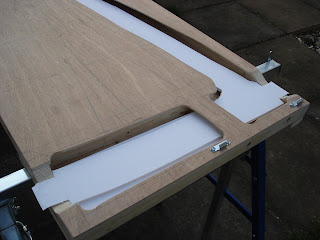Since the 2mm Scale Association laid down their Golden Jubilee Layout Challenge to build a layout of 9.42 sq. ft. or less in time for their 2010 Expo, I have spent a year and a half thinking about it, and now I have a year and a bit to actually build something.
The thinking bit was quite tough, coming up with criteria to be met by the eventual design, and then getting a design that met most of those criteria. The criteria included:
- max area 9.42 sq ft, of course
- maximum baseboard length, 5 ft (for transport)
- interesting to operate and view
- not too complex, given the time constraints
- Southern region, BR 1950's - 1970's
- based on a real location
Finally a suitable prototype presented itself, although it does require generous use of modeller's license. The location is the terminus at Freshwater on the Isle of Wight. Combining a scan of a large scale O.S. map onto the satellite photography of Google Earth, I found that it easily fitted on a 5 ft. by 1 ft 6 inch baseboard, with a fiddle yard of 2 ft 6 inches by 9 inches (total area 9.375 sq. ft).
The original track plan shows lots of interest, with the kick-back sidings and outside single slip. Unfortunately, the layout was rationalised between the wars, and the slip, and two sidings serving the loco facilities were removed, along with the short siding to an end loading bay. An extra spur from the run round, making 3 bufferstops by the station building was added though. For operating interest, all the track from both periods will be retained:

(the purple lattice is 6 inch squares)
To make it possible to extend the operating life of the line, and allow more variety of stock to be used, I have invented a new course of history. Following the war, it was decided to keep the Isle of Wight's rustic charm by banning all road improvements on the island, and restricting motor vehicle use to residents and local businesses. Money saved was put towards the Lymington-Yarmouth rail bridge/tunnel link. All the existing rail routes on the island were then relied upon to convey produce, supplies and holidaymakers. (Britain's version of NASA was based near Freshwater, and might have generated some traffic if it had not been abandoned).
The line from Yarmouth to Freshwater thus became a short branch, with direct trains from Newport and Cowes. Excursions from the mainland would need to reverse at Yarmouth. This new history and generous use of modeller's license means I wil call the layout "Fresherwater".
So much for the ideas, time for something practical. On a visit to the closing down sale at our local Trade Depot I found a pile of plain plywood doors for just £4 each. I felt sure I could do something with one of them, and for that price, I could just dismantle it and use the plywood. First, I would try to make use of the strength of the door's construction.
I started by cutting the door down to 5 ft. long. That is when I realised the faces were not ply, but MDF made to look like ply. However, I continued with my plan, and fitted a length of timber into the cut end, glued and clamped. Then the door was cut lengthways to bring it down to 1 ft. 6 inches wide, and another length of timber glued into the gap at the edge, to give the door its strength back again. The offcut from the end of the door was trimmed to 9 inches, and a length of timber glued in to form the fiddle yard.
Next, I drew out the layout (mirror imaged) to what will be the underside, to determine where point motors and uncoupler magnets will go. This area was then cut out, and the cardboard lattice strengtheners removed from inside the door. More timber framing is then glued in along the edges to return the strength. The photo shows the edge timber clamped while the glue sets, and the first of the timber framing around the central hole in place. So far, the baseboard is still light, and nice and rigid. Note this will be the underside of the layout:














